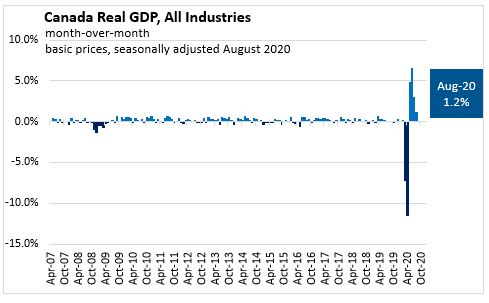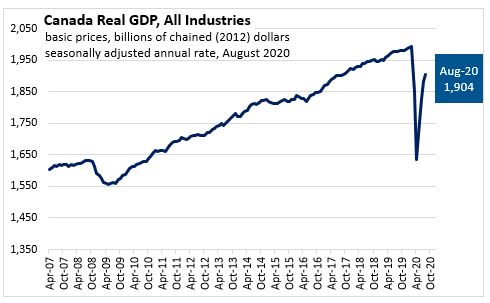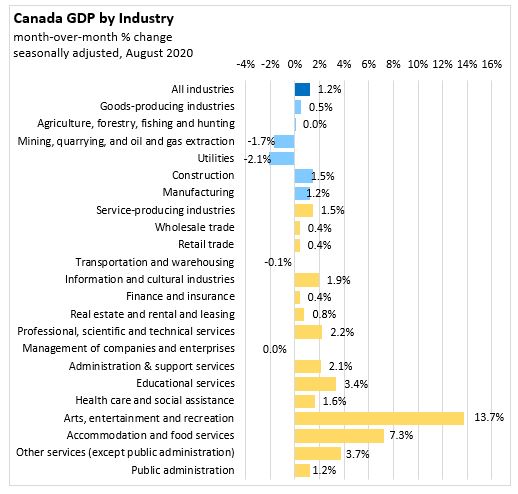The Economics and Statistics Division maintains archives of previous publications for accountability purposes, but makes no updates to keep these documents current with the latest data revisions from Statistics Canada. As a result, information in older documents may not be accurate. Please exercise caution when referring to older documents. For the latest information and historical data, please contact the individual listed to the right.
<--- Return to Archive
For additional information relating to this article, please contact:
October 30, 2020CANADA GDP BY INDUSTRY, AUGUST 2020 Real Gross Domestic Product (GDP) in Canada increased 1.2 per cent in August following a 3.1 per cent increase the previous month. The economy has grown for four consecutive months, recovering from the steepest drops on record in March and April. Real GDP is still 4.6 per cent below the February 2020 pre-pandemic level.
For August 2020, the Canadian economy is 3.8 per cent smaller compared to August 2019 with an annualized value of $1,904 billion (chained 2012 dollars).
Statistics Canada preliminary estimate for real GDP growth in September is 0.7 per cent with gains in manufacturing, public sector, and mining, quarrying and oil and gas. The preliminary estimates point to around a 10 per cent increase in real GDP in Q3.


Goods-Producing Industries
Output for goods-producing sector increased 0.5 per cent with gains in construction and manufacturing
The manufacturing sector output increased 1.2 per cent, the fourth consecutive month of growth but at a slower pace. Gains in durable manufacturing was offset with lower non-durable manufacturing. Gains were seen in machinery, miscellaneous (including medical equipment and supplies), and transportation equipment. Wood product manufacturing grew 8.7 per cent benefitting from heightened domestic and international demand. Declines occurred in electrical equipment, primary metal manufacturing, plastic and rubber products, petroleum, coal and food manufacturing.
Construction GDP was up 1.5 per cent and was less then 2 per cent off of February's pre-pandemic level. Residential, engineering, and repair were all up while non-residential building construction was down.
Oil and gas extraction was down with oil sands extraction (-7.5%) declining to levels last seen in September 2015 following the 2014 oil price crash. Mining (except oil and gas) activities were lower with a decline in potash mining offsetting higher metal ore and coal mining. Utilities declined 2.1 per cent in August after rising on heat records in July.
Services-Producing Industries
Output of services-producing sector increased 1.5 per cent in August 2020.
The public sector (educational services, health care and social assistance, and public administration) grew 1.9 per cent this month and has seen strong recovery growth the last four months. The public sector activity remains below February 2020 levels in educational services (-4.0%), health care and social assistance (-6.4%) and public administration (-1.3%). Education sector was up 3.4 per cent in August with increase at elementary and secondary schools as atypical COVID-19 preparations and online learning setups were made prior to the return of students. Health care and social assistance was up 1.6 per cent with ambulatory health care services growing 1.9 per cent but still remaining approximately 14 per cent below February levels as providers' offices continue to operate at reduced capacity. Nursing and residential care, social assistance and hospital activities were up in August. Public administration was up 1.2 per cent in August with the gradually reopening of service centres and court; however, the majority of public servants continued performing functions remotely.
Professional services was up 2.2 per cent with legal services related to real estate contributing to growth. Real estate and leasing was up with record level of activity at offices of real estate agents and brokers amid strong home resales.
Food services and drinking places grew 5.6 per cents with activity up for all types of restaurants and bars, pubs and some nightclubs amid summer season. Accommodation services grew 12.3 per cent in August but remains nearly 40 per cent below February levels. Arts, entertainment and recreation increased 13.7 per cent amid continued reopening. The National Hockey League restarted 2019/20 season in hub cities (Edmonton and Toronto) with no attendance and Major League Soccer continues play in empty or near-empty stadiums.
Wholesale and retail trade both increased 0.4 per cent in August to now be around 1 per cent larger than pre-pandemic February 2020 levels

Year-to-Date (Jan-Aug 2020 vs. Jan-Aug 2019)
For the first eight months of 2020, the Canada economy has been 5.9 per cent smaller than in 2019. Amid the COVID-19 pandemic and economic recovery, the largest declines in activity have been in arts, entertainment and recreation (-38.5%), accommodation and food services (-32.6%) and transportation and warehousing (-19.0%). Finance and insurance (+4.2%), agriculture, forestry, fishing and hunting (+1.75) and real estate and rental and leasing (+1.5%) have grown in 2020.

Source: Statistics Canada, Table 36-10-0434-01 Gross domestic product (GDP) at basic prices, by industry, monthly (x 1,000,000)
<--- Return to Archive